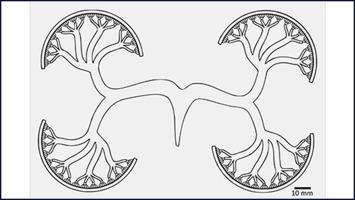Journal of Vascular and Interventional Radiology ( IF 2.9 ) Pub Date : 2022-09-13 , DOI: 10.1016/j.jvir.2022.07.032 Samuel R Miller 1 , Shaphan R Jernigan 1 , Robert J Abraham 2 , Gregory D Buckner 1

|
Purpose
To utilize an in vitro microvascular hepatic tumor model to compare the deposition characteristics of glass yttrium-90 microspheres using the dual-syringe (DS) and traditional bolus administration methods.
Materials and Methods
The microvascular tumor model represented a 3.5-cm tumor in a 1,400-cm3 liver with a total hepatic flow of 160 mL/min and was dynamically perfused. A microcatheter was placed in a 2-mm artery feeding the tumor model and 2 additional nontarget arteries. Glass microspheres with a diameter of 20–30 μm were administered using 2 methods: (a) DS delivery at a concentration of 50 mg/mL in either a single, continuous 2-mL infusion or two 1-mL infusions and (b) bolus delivery (BD) of 100 mg of microspheres in a single 3-mL infusion.
Results
Overall, the degree of on-target deposition of the microspheres was 85% ± 11%, with no significant differences between the administration methods. Although the distal penetration into the tumor arterioles was approximately 15 mm (from the second microvascular bifurcation of the tumor model) for all the cases, the distal peak particle counts were significantly higher for the DS delivery case (approximately 5 × 105 microspheres achieving distal deposition vs 2 × 105 for the BD case). This resulted in significantly higher deposition uniformity within the tumor model (90% for the DS delivery case vs 80% for the BD case, α = 0.05).
Conclusions
The use of this new in vitro microvascular hepatic tumor model demonstrated that the administration method can affect the deposition of yttrium-90 microspheres within a tumor, with greater distal deposition and more uniform tumor coverage when the microspheres are delivered at consistent concentrations using a DS delivery device. The BD administration method was associated with less favorable deposition characteristics of the microspheres.
中文翻译:

体外微血管肝肿瘤模型中玻璃钇 90 微球沉积的推注与双注射器给药系统的比较
目的
利用体外微血管肝肿瘤模型比较使用双注射器 (DS) 和传统推注给药方法的玻璃钇 90 微球的沉积特性。
材料和方法
微血管肿瘤模型代表 1,400 cm 3肝脏中的 3.5 cm 肿瘤,总肝流量为 160 mL/min,并进行动态灌注。将微导管放置在为肿瘤模型供血的 2 毫米动脉和另外 2 条非目标动脉中。直径为 20–30 μm 的玻璃微球使用 2 种方法给药:( a ) DS 以 50 mg/mL 的浓度在单次连续 2 mL 输注或两次 1 mL 输注中递送,和 (b)推注在单次 3 mL 输液中递送 (BD) 100 mg 微球。
结果
总体而言,微球的靶向沉积程度为 85% ± 11%,给药方法之间没有显着差异。尽管所有病例的远端穿透肿瘤小动脉约为 15 毫米(从肿瘤模型的第二个微血管分叉处),但 DS 递送病例的远端峰值颗粒计数明显更高(约 5 × 10 5 个微球达到远端沉积与BD 情况下的2 × 10 5相比)。这导致肿瘤模型内的沉积均匀性显着提高(DS 交付案例为 90%,BD 案例为 80%,α = 0.05)。
结论
这种新的体外微血管肝肿瘤模型的使用表明,给药方法可以影响钇 90 微球在肿瘤内的沉积,当使用 DS 递送以一致的浓度递送微球时,具有更大的远端沉积和更均匀的肿瘤覆盖设备。BD 给药方法与微球较差的沉积特性相关。


























 京公网安备 11010802027423号
京公网安备 11010802027423号